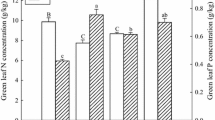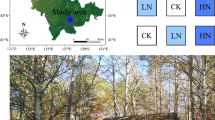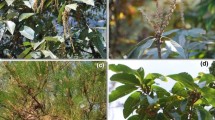Abstract
Chemical and biochemical analysis methods were used to monitor the variations of nitrogen nutrient among the dominance trees species in secondary succession process of the mixed broad -leaved/Korean pine forest on Changbai Mountains, Northeast China. Amounts of total nitrogen, ammonium and NRA in soils of virgin broad-leaved/Korean pine forest which is in climax were higher than those ofsecondary birch forests those are in succession stage. The amount of nitrate was in the other hand. In climax, dominance trees species are tolerant mesophytic trees such asPinus Koraiensis, Tilia amurensis, Acer mono and alsoFraxinus mandshurica, they are all ammonium + nitrate adapted species, but they show a preference for the ammonium rather than those of the pioneer trees species in secondary birch forest, such asPopulus davidiava andBetula platyphylla. Because they have more ammonium in their leaves and roots, especiallyPinus koraiensis. Populus davidvana andBetula platyphlla are intolerant trees, amounts of nitrate and total nitrogen is higher in their leaves and roots and also NRA in their leaves, so they preference for the nitrate rather than the others. In secondary birch forest, the regeneration trees species adapt their nitrogen nutrient to the variation of nitrogen nutrient situation in soil, finally they could survival well and the secondary birch forest would succession to climax. In climax, dominance trees species adapt their Nitrogen nutrient to the situation in soil and there are not strong competition in nitrogen nutrient among them, so they can coexist well and keep the climax as stable vegetation.
Similar content being viewed by others
References
Cheng B.R., 1981, The main soil groups and their properties of the Natural Reserve on northern slope of Changbai Mountain. For. Ecosystem Res. 2: 196–206.
Chi Z.W., 1981, The primary study on waterheat conditions of forest Ecosystem on Northern Slope of Changbai Mountain. For. Ecosystem Res. 2: 167–178.
Hogber, P., 1986, Plant nitrate reductase activity as an indicator of availability of nitrate in forest soils. Canadian Journal of Forest Research, 16, 1165–1169.
Lewis, A.M., 1986, Plant and Nitrogen. Edward Arnold Ltd. London. Moore, P.D., S.B. Chapman, 1986, Methods in Plant Ecology. Blachwell scientific publications, London.
Wang Z., 1980, The main forest types and their features of community structure in northern slope of the Changbai Mountain. For. Ecosystem Res. 1:2542.
Yang H.C., 1988, Tree composftion, age structure and regeneration strategy of the mixed broad-leaf Korean pine forest in Changbaishan Biosphere Reserve, China. Scientia Silvae Sinicae Vol. 24. No. 1, 18–27.
Zheng H.Y., 1982, Biochemistry methods in the dynamic of soil enzymes. Chinese scientific publications, Beijing.
Author information
Authors and Affiliations
Rights and permissions
About this article
Cite this article
Yuwen, L., Yeju, W. Nitrogen nutrient mechanism in secondary succession process of the mixed broad-leaved/Korean pine (Pinus koraiensis) forest. J. Northeast For. Univ. 6, 100–104 (1995). https://doi.org/10.1007/BF02880643
Issue Date:
DOI: https://doi.org/10.1007/BF02880643




